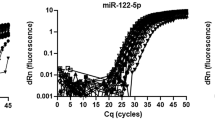Abstract
Understanding of the functional significance of microRNAs (miRNAs) requires efficient and accurate detection method. In this study, we developed an improved miRNAs quantification system based on quantitative real-time polymerase chain reaction (qRT-PCR). This method showed higher efficiency and accuracy to survey the expression of primary miRNAs (pri-miRNAs), precursor miRNAs (pre-miRNAs), and mature miRNAs. Instead of relative quantification method, we quantified the pri-miRNAs and pre-miRNAs with absolute qRT-PCR based on SYBR Green I fluorescence. This improvement corrected for the inaccuracy caused by the differences in amplicon length and PCR efficiency. We also used SYBR Green method to quantify mature miRNAs based on the stem–loop qRT-PCR method. We extended the pairing part of the stem–loop reverse transcript (RT) primer from 6 to 11 bp, which greatly increased the efficiency of reverse transcription PCR (RT-PCR). The performance of the improved RT primer was tested using synthetic mature miRNAs and tissue RNA samples. Results showed that the improved RT primer demonstrated dynamic range of seven orders of magnitude and sensitivity of detection of hundreds of copies of miRNA molecules.






Similar content being viewed by others
References
Orellana, E. A., & Kasinski, A. L. (2015). MicroRNAs in cancer: A historical perspective on the path from discovery to therapy. Cancers, 7(3), 1388–1405.
He, L., & Hannon, G. J. (2004). MicroRNAs: Small RNAs with a big role in gene regulation. Nature Reviews Genetics, 5, 522–531.
Wang, X., Xu, X., Ma, Z., Huo, Y., Xiao, Z., Li, Y., & Wang, Y. (2011). Dynamic mechanisms for pre-miRNA binding and export by exportin-5. RNA, 17(8), 1511–1528.
Hammond, S. M., Bernstein, E., Beach, D., & Hannon, G. J. (2000). An RNA-directed nuclease mediates post-transcriptional gene silencing in Drosophila cells. Nature, 404, 293–296.
Liu, G., Zhang, R., Xu, J., Wu, C. I., & Lu, X. (2015). Functional conservation of both CDS- and 3′-UTR-located microRNA binding sites between species. Molecular Biology and Evolution, 32(3), 623–628.
Liu, J., Valencia-Sanchez, M. A., Hannon, G. J., & Parker, R. (2005). MicroRNA-dependent localization of targeted mRNAs to mammalian P-bodies. Nature Cell Biology, 7, 719–723.
Bartel, D. P. (2009). MicroRNAs: Target recognition and regulatory functions. Cell, 136, 215–233.
Sylvia, K., & Suresh, K. (2009). MicroRNA function in cancer: Oncogene or a tumor suppressor? Cancer and Metastasis Reviews, 28, 369–378.
Lee, D. Y., Hayes, J. J., Pruss, D., & Wolffe, A. P. (1993). A positive role for histone acetylation in transcription factor access to nucleosomal DNA. Cell, 72(1), 73–84.
Lagos-Quintana, M., Rauhut, R., Yalcin, A., Meyer, J., Lendeckel, W., & Tuschl, T. (2002). Identification of tissue-specific microRNAs from mouse. Current Biology, 12(9), 735–739.
Streit, S., Michalski, C. W., Erkan, M., Kleeff, J., & Friess, H. (2009). Northern blot analysis for detection and quantification of RNA in pancreatic cancer cells and tissues. Nature Protocols, 4(1), 37–43.
Yin, J. Q., Zhao, R. C., & Morris, K. V. (2008). Profiling microRNA expression with microarrays. Trends in Biotechnology, 26, 70–76.
Duan, D., Zheng, K. X., Shen, Y., Cao, R., Jiang, L., Lu, Z., et al. (2011). Label-free high-throughput microRNA expression profiling from total RNA. Nucleic Acids Research, 39(22), e154.
Chen, C., Ridzon, D. A., Broomer, A. J., Zhou, Z. H., Lee, D. H., Julie, T., et al. (2005). Real-time quantification of microRNAs by stem-loop RT-PCR. Nucleic Acids Research, 33(20), e179.
Pritchard, C. C., Cheng, H. H., & Tewari, M. (2012). MicroRNA profiling: Approaches and considerations. Nature Reviews Genetics, 13, 358–369.
Livak, K. J., & Schmittgen, T. D. (2001). Analysis of relative gene expression data using real-time quantitative PCR and the 2(-Delta Delta C(T)). Methods, 25, 402–408.
Thomas, D., Leea, E. J., Jianga, J., Sarkarb, A., Yang, L., Eltona, T. S., & Chen, C. (2008). Real-time PCR quantification of precursor and mature microRNA. Methods, 44, 31–38.
Lagos-Quintana, M., Rauhut, R., Lendeckel, W., & Tusch, T. (2001). Identification of novel genes coding for small expressed RNAs. Science, 294, 853–858.
Lau, N. C., Lee, P. L., Weinstein, E. G., & Bartel, D. P. (2001). An abundant class of tiny rnas with probable regulatory roles in Caenorhabditis elegans. Science, 294, 858–862.
Lee, R. C., & Ambros, V. (2001). An extensive class of small RNAs in Caenorhabditis elegans. Science, 294, 862–864.
Lee, E. J., Baek, M., Gusev, Y., Brackett, D. J., Nuovo, G. J., & Schmittgen, T. D. (2008). Systematic evaluation of microRNA processing patterns in tissues, cell lines, and tumors. RNA, 14(1), 35–42.
Acknowledgments
This work was supported by “The Key Project of Science and Technology Commission of Shanghai Municipality (Nos. 12140900404 & 14140900502)”. We appreciate Dr. Changrui Lu for the constructive advice in English writing of this paper.
Author information
Authors and Affiliations
Corresponding author
Additional information
Li Tong and Huihui Xue have contributed equally to this work.
Electronic supplementary material
Below is the link to the electronic supplementary material.
Rights and permissions
About this article
Cite this article
Tong, L., Xue, H., Xiong, L. et al. Improved RT-PCR Assay to Quantitate the Pri-, Pre-, and Mature microRNAs with Higher Efficiency and Accuracy. Mol Biotechnol 57, 939–946 (2015). https://doi.org/10.1007/s12033-015-9885-y
Published:
Issue Date:
DOI: https://doi.org/10.1007/s12033-015-9885-y




